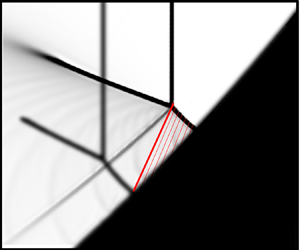Article contents
Similarity in Mach stem evolution and termination in unsteady shock-wave reflection
Published online by Cambridge University Press: 03 September 2020
Abstract

Shock-wave reflection over concave surfaces poses a difficulty in its analysis due to the unsteady nature of the reflection process and the occurrence of various types of Mach reflections caused by it. In a pseudo-steady flow, the reflection's configuration is self-similar since the shock wave reflects over a surface with constant inclination. The unsteady Mach reflection introduces an additional complexity as it is affected by the changing inclination of the surface, forcing the reflection to continuously adjust itself to the varying boundary condition. In this study, validated simulations of Mach reflection (MR) over cylindrical concave surfaces with different radii were performed for three inviscid perfect gases with moderate incident shock Mach numbers (Ms) ranging from 1.3 to 1.5. The reflection was investigated up to the point of transition from MR to transitioned regular reflection. A similar behaviour of the configuration and evolution of the Mach stem was observed, one that is independent of the surface radius and type of gas. With regards to different gases, the speed of sound a0 is a dominant factor since it dictates the propagation of wall disturbances. A universal condition of the rate of surface change was found, accounting for different radii, different gases and Ms variation. Analysis based on shock dynamics is employed to explain how disturbances caused by surface variations play a significant role in the behaviour of the reflection. This method successfully supports the similarity that was demonstrated and facilitates a more informed perception of the MR process.
- Type
- JFM Papers
- Information
- Copyright
- © The Author(s), 2020. Published by Cambridge University Press
References
- 3
- Cited by



